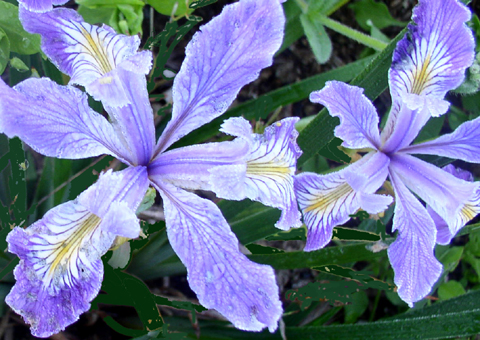|
 |

This is an archived web page which we no longer display at our website, and which is for information only. After the freeze of December 2010, we have relatively Pacific Coast iris in the gardens, and none for sale.
Sundquist Nursery in Poulsbo, WA. opens its gardens on specific dates each year. We have scores of named hybrids and species in our beds. For 2009, we have a nice selection (more than twenty forms, including some unusual colors) of PCIs available for purchase at the nursery during each of our Spring open events. Shop early, starting April 10-11, for the best selection. Some may be blooming for our May 1-2 open days; the best viewing opportunity this year will be May 29-30.
Pacific Coast Iris in the Maritime Northwest
There are 11 native Pacific Coast iris (PCI) species.
Iris tenax (Oregon iris) is native in southwest Washington and along the flanks of the Oregon Cascades, along with a disjunct population in California’s Klamath Mountains. The species grows up to 4000’ elevation near Mt. Hood, and is the most winter hardy of the PCIs. I. tenax demands well drained soil. It is also deciduous—a defense against severe winters. Many hardy hybrids tracing their lineage back to tenax may not be very evergreen, at least in cold winters.
I. douglasiana (Douglas iris) is found along the coast from south-central Oregon to south-central California. It is adapted to a wide range of microclimates in its range and is probably the PCI species most adapted to a wide range of garden settings, especially on the west slope from Puget Sound north. I. douglasiana is reliably evergreen and accepts some lingering moisture in the soil.
Flowers on both tenax and douglasiana are, respectively, frequently in shades of reddish purple or mauve blue. But occasional variants are found in colors ranging from near pink to yellow and white.
PCI hybrids trace their lineage to many of the 11 native species, and the precise parentage of many hybrids is unclear. The range of color combinations, blotches, signals, and venation is just about unequalled in the genus. Mature sizes are compact, usually one to two feet. Many are evergreen or nearly so. Generally speaking, PCI hybrids with tenax and douglasiana in their ancestry offer the most potential for Maritime Northwest gardeners. Unfortunately for northern gardeners, modern breeding has emphasized flower characteristics, not durability in a range of conditions. There is very little baseline information about which PCI hybrids perform well in the Maritime Northwest. Finding out which varieties grow best is often a matter of experimentation, especially with new ones. While some hybrids are very unforgiving of our conditions, it’s still fair to say numerous hybrid PCIs with wide-ranging parentage are good performers and worthwhile plants here.
In Puget Sound, PCIs can be grown in partial (open) shade or out in full sun. They require freely drained soils and resent traditional heavy summer irrigation regimes and mulch over the crown. Winter rain, where soil is not saturated, is usually not a problem
But too much moisture—especially in summer—and mulch on the crown are the reasons why PCIs may fail to thrive in typical “garden” settings. The good news, however, is that PCIs are compatible with situations where watering and mulching are reduced. PCIs provide considerable drought tolerance and ease of care for gardeners wishing to create environmentally sustainable, efficiently maintained, “natural” gardens.
To grow PCIs well, keep in mind that most of the native species are found in open scrubby understory, along woodland edges, or in open meadows where there is some organic matter present and the soil is well-drained. Provide a sloping or slightly raised bed, or freely drained soil. Amend with aged bark, aged chips, or compost. Provide little or no supplemental irrigation. If you irrigate, do so with some consistency of frequency and absolutely only in the cool of early morning in summer, never during the heat of the day. Moist soil at elevated summer temperatures will promote diseases deadly to PCIs. Mulching over the crown usually contributes to water retention and is therefore usually a bad idea. Keep mulches several inches away from the foliage. If you encounter disease problems over time, it will probably help if you can move your irises to a new location, just like a farmer practicing crop rotation.
To provide a clean appearance, PCIs can be cut back in late winter or early spring, just like ferns, epimediums, or hellebores.
Congested crowns or accumulations of dead leaves on established plants can promote water retention and disease. PCIs should be rejuvenated every third year or so by dividing immediately after the onset of fall rain, while soils are still warm from summer but are newly damp, usually the first half of October in Puget Sound. There is another window during the second half of March or early April when they can be divided. Spring divisions don’t have as long to become established before the stress of summer arrives, so might need more attention. Divided plants can be testy, and are usually happier immediately replanted in the ground rather than in pots. Sizewise, be a little generous, not greedy. Divisions smaller than fist-sized can be sensitive and are for experienced hands only. Remove old frass and dead roots. Avoid breaking fresh white roots, and never allow them to dry out.
PCIs are plants for modern Northwest gardens because they provide extraordinarily beautiful flowers, grow in sun or part shade, are drought tolerant, fit into small spaces, and require low levels of maintenance. In addition, many are evergreen. When their simple requirements are met, PCIs are extremely gratifying as pathside accents or in groups.
Thank you to Colin Rigby, Carla Lankow, Richard Greenberg, Jean Witt, Terri and Jay Hudson, and others who’ve generously shared over the years.
Copyright 2003 - present, Nils Sundquist, Sundquist Nursery, Inc. Permission to reprint may be granted on request.
|